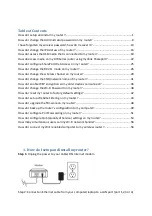
6-7
Cisco Aironet 1130AG Series Access Point Hardware Installation Guide
OL-6226-02
Chapter 6 Troubleshooting
Low Power Condition
On power up, the access point is placed into low power mode (both radios are disabled), Cisco IOS
software loads and runs, and power negotiation determines if sufficient power is available. If there is
sufficient power then the radios are turned on; otherwise, the access point remains in low power mode
with the radios disabled to prevent a possible over-current condition. In low power mode, the access
point activates the Status LED low power error indication, displays a low power message on the browser
and serial interfaces, and creates an event log entry (see the
“Checking the Access Point LEDs” section
and
“Inline Power Status Messages” section on page 6-7
Intelligent Power Management
The access point requires 12.95 W of power for full power operation with both radios, but only needs
6.3 W of power when operating in low power mode with both radios disabled. To help avoid an
over-current condition with low power sources and to optimize power usage on Cisco switches, Cisco
developed Intelligent Power Management, which uses Cisco Discovery Protocol (CDP) to allow
powered devices (such as your access point) to negotiate with a Cisco switch for sufficient power.
The access point supports Intelligent Power Management and as a result of the power negotiations, the
access point will either enter full power mode or remain in low power mode with the radios disabled.
Note
Independent of the power negotiations, the access point hardware also uses the 802.3af classification
scheme to indicate the power required from the power source. However, the power source cannot report
the power available to the access point unless the power source also supports Intelligent Power
Management.
Some Cisco switches that are capable of supplying sufficient power require a software upgrade to
support Intelligent Power Management. If the software upgrade is not desired, you can configure the
access point to operate in pre-standard compatibility mode and the access point automatically enters full
power mode if these Cisco switches are detected in the received CDP ID field.
When the access point determines that sufficient power is not available for full power operation, an error
message is logged and the Status LED turns amber to indicate low power mode (see the
Access Point LEDs” section on page 6-2
“Inline Power Status Messages” section on page 6-7
).
Tip
If your switch is capable of supplying sufficient power for full operation but the access point remains in
low-power mode, your access point or your switch (or both) might be misconfigured (see
and
).
If your inline power source is not able to supply sufficient power for full operation, you should consider
these options:
•
Upgrade to a higher-powered switch
•
Use a Cisco Aironet power injector on the switch port
•
Use the 48-VDC power module to locally power the access point
Inline Power Status Messages
These messages are logged on the console port by the access point to report the power condition:
•
%CDP_PD-4-POWER_OK: Full Power - AC_ADAPTOR inline power source—This message
indicates the access point is using the power module and can support full-power operation.
















































